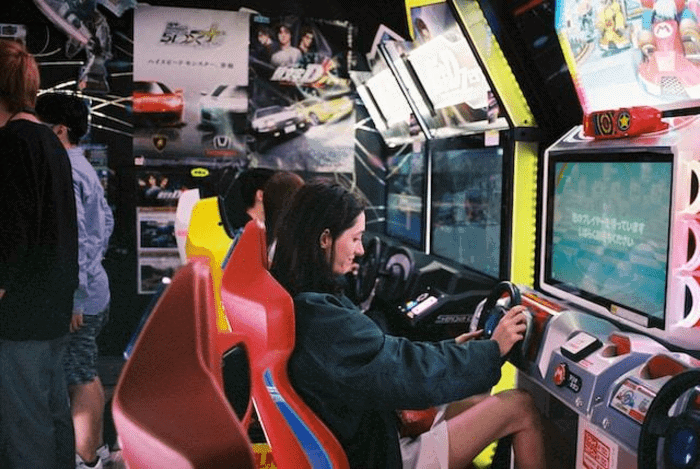Sega, Nintendo, and Sony are some of the biggest gaming giants who have shaped the electronic entertainment landscape. All operate from Japan, bringing quality games, iconic characters, and fun worldwide. It’s no wonder that Japanese people have a thriving gaming scene and culture. From consoles to mobile, online gaming, and real-life cosplay, even arcades are still lingering in Japan. With such a rich backstory, Japanese people have plenty to choose from.
1. Arcades
Starting from the beginning, it’s impossible to mention gaming without Space Invaders. From its humble beginning, the Taito company made Space Invaders in 1978, launching them on the arcade system and the rest is history. Even today, with the rise of technology, which moved games from the arcades onto our PCs, consoles, and mobiles, plenty of arcade style racing, fighting, shooting and adventure games are still present in Japan.
Iconic games like Pac-Man, Street Fighter, Donkey Kong, Galaga, and Contra, all had parts of their history in the arcades which operate to this day. Nowhere in the world is the arcade culture and market more thriving than in Japan, bringing in over $2.8 billion in 2020, where students are mostly responsible for the impressive sum.
2. Gacha games
Vending machines in Japan come in forms like you’ve seen on carnivals. You guide a hook with which you must grab a prize from a pool and safely bring it back to you. Gacha games stem from the word gachapon, where gacha is the sound a toy vending machine cranks out while you play, and pon is for the toy capsule you get.
Today gacha games are played on mobile as their accessibility has allowed more people to play. Players in gacha games like Genshin Impact spend real currency for in-game loot boxes and digital rewards. The gambling nature of gacha games can also be seen in sites listed on New Japanese Casinos, with the exception that you can receive real currency from the latter while playing if you win. Many compare loot boxes to these gambling sites, with some feeling that loot boxes should be more tightly controlled and regulated, like gambling is.
Despite this, Honkai Star Rail is currently one of the most popular gacha games in Japan, where players fly through space and customize their avatar and spaceship with in-game currency or real money. Both are used to obtain random virtual items, characters, and equipment via gacha mechanics called “gacha pulls” or “loot boxes” for those more familiar.
3. Otome games
In 1994, the game Angelique was published by the Koei company and developed by an all-woman team of Ruby Party, starting the genre of otome games. They are intensely story-based games that revolve around developing romantic interest between in-game characters, where most of them are male. The genre has since been established amongst female players in Japan and has had resounding success with women in their 20s. Utano Prince Sama, Amnesia, and Hakuoki are some of the names that stand out in the genre, some of which have also gotten an anime adaptation.
The unique perspective of developing digital characters, a rich gaming story, lovely game avatars’ personality, and infusing the game with romantic interest has ignited the imagination of this specific segment of Japan’s gaming industry. Otome games generate $733 million, and when we factor in strong emotion and dedicated brand loyalty because feelings are involved, it’s easy to see how and why these types of games are popular in Japan.
4. RPG games
Speaking of the importance of stories in games, role-playing games have been at the root of Japanese gaming culture since its earliest beginning. The titan of the industry is the Final Fantasy series, debuting in 1987. Since then, it has had 16 official releases to date, including a movie and an MMO. Many titles in the series are ranked very highly, over 90% on Steam. The difference between this type of RPG game and any otome game is the added elements of action, adventures, fighting, and developing each character a player controls.
Final Fantasy exists on all console platforms and even on mobile, where its appeal is found in incorporating the elements of traditional Japanese folklore into its game. The graphic quality of the games has always been exceptional, its cast of characters diverse, and its narrative rich. The name alone captivates Japanese players and is symbolic for many of them. On the same note, the “Souls series” made by FromSoft is also prominent in Japan and internationally.
Games like Demon Souls, Dark Souls 1,2, and 3, Elden Ring, and others have lots of RPG characteristics and mechanics, with their difficulty being pushed to the maximum. Such a sub-genre of difficult games has also found its niche in Japan, emphasizing the Japanese strive for perfection and performance under pressure to the maximum!
5. Fighting games
One-on-one duels have always raised spirits and blood pressure, making the genre of fighting games thrive on virtual conflict. Karate Do came out in 1984 and was made by Technos Japan, igniting the competitive aspect of gaming and launching the popularity of fighting games in the arcades. Riding on its wave of success, the fighting games genre saw the rise of Street Fighter by Capcom in 1987, Super Smash Bros by Nintendo in 1999, and Virtua Fighter, which was the first 3D fighting game released by Sega in 1993.
Later, big names like Tekken were released for the PlayStation in 1994 by Bandai Namco and Guilty Gear by Arc System Works in 1998, all popularized button mashing, combo making, and flashy combat. The competitive nature of the genre was so high, that it led to the formation of Evolution Championship Series, a dedicated esports event for fighting games!

